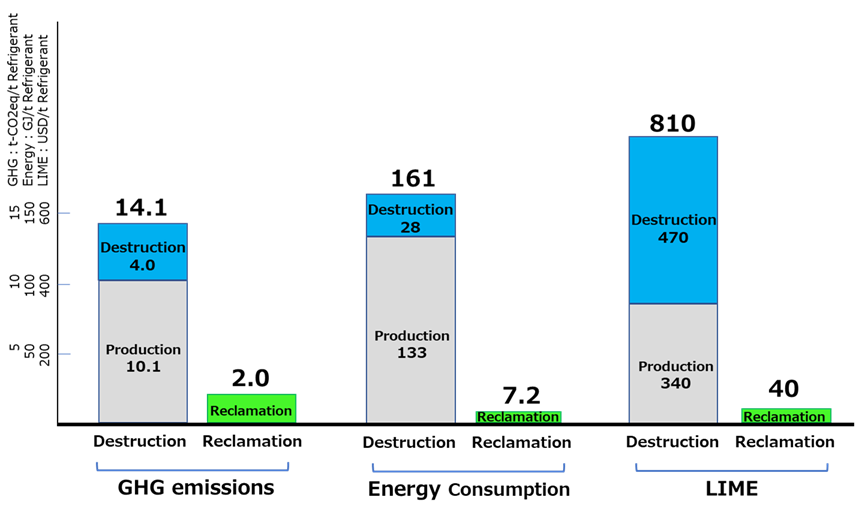Press Releases
Advocates Refrigerant Recovery and Reclamation for Global Warming Mitigation and Realization of a Zero-Waste Society
Daikin Industries, Ltd. has recently conducted a life-cycle assessment (LCA) comparing the relative environmental impacts of reclamation treatment and destruction treatment1 of refrigerants recovered from air conditioning equipment and published the results in a research paper. .
Refrigerants recovered during the replacement and maintenance of air conditioning equipment can be reclaimed by removing impurities, and the recovery and reclamation are required to mitigate the effects of global warming and realize a zero-waste society. However, the refrigerant recovery rate for commercial air conditioners and refrigeration systems remains at around 40% in Japan. Most of the recovered refrigerant is also destroyed while only around 30% of the refrigerant reclaimed (R410A case). In addition to improving the recovery rate, simultaneously improving the reclamation rate is expected to have a positive effect in terms of global warming mitigation and resource circulation and could help alleviate refrigerant supply shortages. To support these advantages quantitatively, Daikin evaluated and compared the environmental impact of destroying and reclaiming recovered refrigerants.
Three indicators, greenhouse gas (GHG) emissions, energy consumption, and LIME2, which comprehensively evaluates environmental impacts for not only global warming but also for various areas including health and biodiversity, were used. Compared to destruction treatment, the environmental impact of reclamation treatment for the refrigerant R410A yielded values that were about 1/7 of GHG emissions, 1/25 of energy consumption, and 1/20 of LIME. Irrespective of refrigerant type (which included R410A, R32, R134a, and R22) or processing region (Japan and Europe), the values in the reclamation process were lower than those of the destruction process for all indicators. Consequently, it is now quantitatively clear that the reclamation process is desirable in terms of mitigating global warming and resource circulation.
Together with further promotion of refrigerant recovery and reclamation, Daikin promote the prevention and control of refrigerant leaks, rapid transition to refrigerants with low global warming potential (GWP), and the development of practical refrigerants that are well-balanced in terms of overall aspects of safety, environmental impact, energy efficiency, and cost effectiveness. Through these activities, Daikin is contributing toward the mitigation of global warming and the realization of a zero-waste society.
In the processing of the recovered refrigerant, figures in all indicators of GHG emissions, energy consumption, and LIME are smaller in the reclamation treatment than in the destruction treatment, meaning the comprehensive environmental impact is also smaller.
Reclamation treatment for R410A in Japan yields values that are about 1/7 of GHG emissions, 1/25 of energy consumption, and 1/20 of LIME compared to destruction treatment.
Refrigerant recovery is highly effective in mitigating global warming, and improvement in refrigerant recovery rate is essential.
From the results of comprehensive environmental impact analysis using LIME, reclamation treatment is desirable from the viewpoints of resource circulation and circular economy in reducing waste and minimizing the need for new mining of fluorite, a raw material used in refrigerants.

Depending on application, a variety of refrigerants are used in air conditioners and refrigeration systems, andthe most balanced refrigerant has been adopted in terms of overall aspects of safety, environmental impact, energy efficiency, and cost-effectiveness.
Currently, HFC refrigerants are widely used since they do not deplete the ozone layer. However, because they have high GWP values, the Kigali Amendment to the Montreal Protocol, which was adopted in 2016, stipulates the gradual phase down of HFC refrigerants. In Japan, the Act on the Protection of the Ozone Layer promotes a gradual phase down in the production and consumption of HFC refrigerants.
In regard to HFC refrigerants, transition to refrigerants with lower GWP values is being promoted. In Japan, residential and light commercial for small business air conditioners have already completed transition from R410A (GWP: 1924) to R32 (GWP: 677), and transition of multi-split air conditioners for buildings(VRF)is scheduled to begin in 2025.
While the production and consumption of HFC refrigerants are gradually being phased down, supply of R410A, whose demand will continue in the interim for after service usage in existing equipment, may fall short of demand. Reclamation of recovered refrigerant is also expected to ensure a stable supply of refrigerant.
Actual plant data were compiled with the cooperation of seven related companies for the manufacture of refrigerants, their reclamation, and their destruction. The LCA evaluation was conducted by TCO2 Co., Ltd.![]() , and third-party verification was conducted by Norihiro Itsubo, professor at Tokyo City University. Evaluation was conducted using the three indicators of GHG emissions, energy consumption, and LIME, and the results were jointly compiled into a peer-reviewed paper.
, and third-party verification was conducted by Norihiro Itsubo, professor at Tokyo City University. Evaluation was conducted using the three indicators of GHG emissions, energy consumption, and LIME, and the results were jointly compiled into a peer-reviewed paper.
For details, please refer to the open access paper published below.
Article

Yasaka, Y.; Karkour, S.; Shobatake, K.; Itsubo, N.; Yakushiji, F.
Life-Cycle Assessment of Refrigerants for Air Conditioners Considering Reclamation and Destruction. Sustainability 2023, 15, 473.
https://doi.org/10.3390/su15010473Find out more in your region.